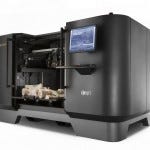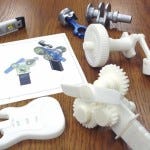

Also known as “additive manufacturing”, 3D printing creates real, solid objects one layer at a time using digital designs. Although it can be difficult to wrap your head around how the image on your screen can be a 3D object in your hand, it is even more extraordinary when it happens before your eyes.
3D printing is different from traditional machining techniques, which rely on the removal of material with methods such as cutting, drilling or lathing (subtractive manufacturing).
A materials printer performs 3D printing processes using digital technology building your object up layer by layer. It’s a fantastic opportunity to manufacture one off objects without the need for labour intensive prototypes. This means objects can be manufactured on a scale that suits the demand of the product, and without the need for numerous components as the object can be made in one piece. This customisation allows for changes between prints also, which can permit custom objects each time.
Computer aided design (CAD) drawings or modelling software designs allows additive manufacturing machines to “slice” the virtual model into digital cross sections for reference. With the popularity of 3D printing, there are many makes and models of machines on the market, so the material used to “build” the object may vary and operators will select different materials based upon what the function of the object is. Some object may require hard, rigid plastic, others may demand a greater level of flexibility.
Check out these You Tube demonstrations by Objet Geometries.






